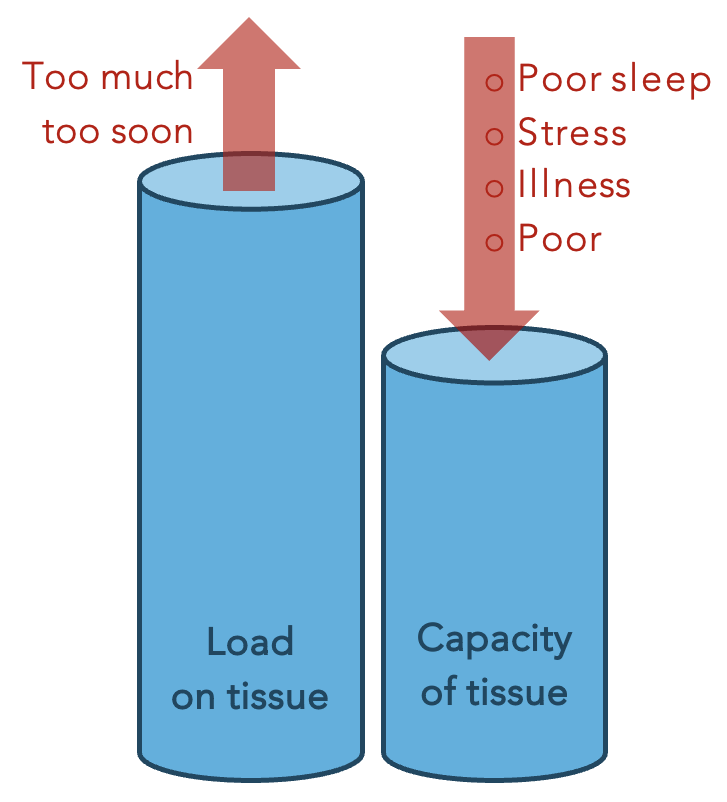In the pursuit of better fitness and overall health, many of us aspire to increase our exercise capacity. Whether it’s running a marathon, lifting heavier weights, or simply being able to walk longer distances without fatigue, expanding our physical capabilities is a common goal. However, achieving this isn’t just about pushing harder; it requires a deeper understanding of the interplay between tissue load and capacity within our bodies.
Tissue Load vs Capacity
Tissue load refers to the stress placed on our muscles, tendons, ligaments, and other bodily tissues during physical activity. When we exercise, we subject our bodies to various forms of stress, such as tension, compression, and torsion. These stresses are essential for triggering physiological adaptations that lead to improved strength, endurance, and overall fitness.
On the other hand, tissue capacity represents the ability of our bodily tissues to tolerate and adapt to the stresses imposed upon them. This capacity isn’t fixed; it can be enhanced through systematic training and conditioning. When we push our bodies through progressive overload – gradually increasing the intensity, duration, or frequency of exercise – we stimulate adaptations that bolster our tissue capacity.
Balancing Load and Capacity
So, every tissue in the body has a total load it can tolerate. When we apply a load greater than the tissue’s capacity, this can lead to injury, pain and setbacks. Conversely, if the load remains too low, our tissues won’t be sufficiently challenged to adapt and grow stronger.
Injury scenario one: Too much too soon
Acute injury where a sudden increase in load is greater than your tissues capacity and there is no no time to adapt. For example, rolling your ankle.
An overuse injury where you place an increased load on your body without appropriate time for the tissues to adapt. For example, beginning a new program at the gym and expecting to be able to start straight away with high weights, high reps, or high intensity and not progressively building up to it.
Injury scenario two: Reduced tissue capacity
Factors that affect out ability to recover and our readiness to do an activity need to be taken into consideration. For example, poor sleep, increased stress, illness, increased stress, poor sleep, nutrition, beliefs and previous injury.
Strategies to Enhance Exercise Capacity
- Progressive Overload: Gradually increase the intensity, duration, or frequency of your workouts over time. This progressive approach allows your tissues to adapt gradually, reducing the risk of injury.
- Proper Form and Technique: Performing exercises with proper form ensures that the load is distributed evenly across the targeted tissues, minimizing the risk of strain or injury.
- Rest and Recovery: Adequate rest and recovery are essential for allowing tissues to repair and rebuild stronger. Incorporate rest days into your workout schedule and prioritize quality sleep.
- Nutrition: Provide your body with the nutrients it needs to support tissue repair and growth. Consume a balanced diet rich in protein, carbohydrates, healthy fats, vitamins, and minerals.
- Cross-Training: Engage in a variety of activities to prevent overuse injuries and promote overall fitness. Incorporating activities such as swimming, cycling, or yoga can help balance out the stress placed on different tissues.
- Listen to Your Body: Pay attention to signals of fatigue, discomfort, or pain during exercise. Pushing through pain can lead to injury, so it’s important to know when to dial back the intensity or take a break.
Conclusion
Just pushing harder wont increase exercise capacity; it’s about understanding the dynamic interplay between tissue load and capacity. By gradually increasing the stress placed on our bodies through progressive overload and supporting our tissues with proper form, nutrition, and recovery, we can expand our physical capabilities safely and effectively. Remember, the journey to improved fitness is a marathon, not a sprint – prioritize consistency, patience, and sustainable practices for long-term success.
The key lies in recognising when the load you are placing on your body is higher than your tissues can tolerate or when your tissue capacity is reduced and to accommodate these changes appropriately to reduce the likelihood of pain and injury. This great video “Load vs Capacity and Injuries” from Kevin Maggs @RunningReform gives a clear explanation. If you need assistance in this approach, or you’re getting back to exercise after injury, we can help.
